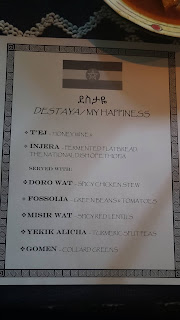For our 8th meal, I chose Ethiopia. I have been a fan of Ethiopian cuisine since college, when I met my good buddy Dan, who used to take us to Queen of Sheba restaurant. I wanted to try to recreate some of those happy memories, so named this meal ደስታዬ (destaya), an Amharic word I found which means "my happiness."
Over the past 5 days, I fermented a mixture of teff and water in preparation for making injera (እንጀራ; Ethiopia's distinctive sour flatbread). However, today, after 7 hours of cooking all the other dishes, the power went out RIGHT as I was about to make the injera. I had heated up the electric grill and just ladled on the batter, but it wasn't able to cook on the residual heat. DAMN!
This was disappointing, but in some ways, apt -- 57% of Ethiopians, and 73% in rural areas, live without access to electricity. (Of course, injera would traditionally be made without electricity, on a large clay plat over a fire- which we were not equipped to do - but still.) It was ironically the first time in 2 years we have lost power in our house, but apparently in Ethiopia, even in homes and businesses that do have power, outages are very common -- one study I saw said 8x per month lasting 6 hours at a time.
In the end, everything was delicious! Definitely a labor of love to prepare. Our favorite was the misir wat (spiced red lentils), shown from 3-6 o'clock in this photo.
Many similar ingredients were used across the dishes (if onions are healthy, Ethiopian cuisine must be the healthiest in the world, this meal took 6 large onions!). I really enjoyed the flavor of the niter kibbeh (spiced ghee), which was an ingredient in every dish, and the berebere spice mix I prepared, which was in most.
 |
| Toasting spices to make berebere - the cooled whole spices and chiles are ground and mixed with others |
The berebere recipe I made said it made 18 servings, but I used all of it in these dishes, and was still short a tablespoon! I read an interesting blog post which said that "The implied cultural whisper has always been that spicy/hot dishes [wots] are the stars of the cuisine, whereas alitcha [non-spicy] dishes are for virgins, wimps or people on medication." I would have been happy even to make the food spicier, so I must be really tough. (Ha ha.) In reality, I suspect these recipes, which I found in English online and which were really pretty mild, may have been toned down for a western palate.
We weren't able to get real t'ej (Ethiopian honey wine), but the internet suggested riesling mixed with honey would be a reasonable substitute, and my tastebuds agreed.
After dinner (once the power came back on), we watched Lamb (2015), about a half-Jewish Ethiopian boy, Ephraim, who is sent to live with relatives after his mother perishes in a drought. He brings along his pet lamb, Chuni, but like everyone else, his extended family is hard up for food, and Chuni is in danger of being slaughtered for the upcoming holiday. The scenery was gorgeous in this film and the human stories were very humanizing and touching. It was also neat watching the family make and eat injera -- although Ephraim is bullied by his uncle, because "boys don't cook."
As a Jew myself, I had heard of African Jews, but I did not know specifically that there were Jews in Ethiopia, or anything about their millennia long history or their persecution. Interestingly, they speak Ge'ez, not Hebrew. You can learn about them here.
When? August 15, 2020
Who cooked? Lauren
What's for dinner? (Recipe links) t'ej, injera (did not actually get to make, but this is the recipe I was working from), berebere, doro wat, fossolia, misir wat, yekik alicha, gomen -- where a couple of these recipes called for canola or coconut oil, I used niter kibbeh instead
Ethiopia Stats
- Population: 109,224,414
- GDP: 195.8 (62nd in the world)
- Life Expectancy: 66.2 (144th in the world)
- Founding Date/Age in 2020: 900 / 1120 pretty damn old
- Official Language: Amharic, which I think has such a beautiful script
- Earliest human settlement: 195,000 years ago
- Best performance at World Cross Country Running Championships (27 wins)
- Lowest Web Index score according to the World Wide Web Foundation (0), which I understand to reflect lack of connectivity
- Largest contributor to UN Peacekeeper Force









